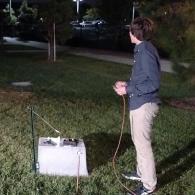Technical Update
(Written November 10th, 2014)
On this day we decided to experiment with the different variables that come with setting up a fence. Since we’d be working with improving and detecting breaks in electric fences, we thought it would work in our favor to have a deep understanding of them. If we do not have all the facts early on, when we really get into prototyping and refining, we could be making a big mistake in our design and be set far back. In order to obtain the necessary information, we decided to test two variables: How far apart the fence posts are, and how far the grounding pole for our fence is in the ground. As a team we realized these contingencies could be key factors in making our device.
First, we set up a fence that was 100 ft long, all four poles were about 20 ft apart, and the grounding pole was two inches in the ground. After that we took our oscilloscope and measured the voltages we got coming from the fence. We got around 450 volts for our measurements on that. We then rearranged the fence, and put all the posts 7.5 feet apart with an all together length of 30 ft, and put the grounding pole 4 inches in the ground. We got the same exact measurements as the last time. Finally, we tried putting the poles 2.5 feet apart, creating an overall length of 10 ft, and put the grounding pole 6 in into the ground. We set up all our equipment and there was no difference. For our last attempt, we used only three posts, each about 1.6 ft apart, creating an overall length of 5 ft; and put the grounding pole 6 in into the ground. Still there was no difference in voltage. After reviewing the measurements of all our setups, we concluded that the length between posts and how far the grounding pole is in the ground are independent variables. They do not affect the amount of voltage going throughout the fence.

Written by Lexi Colmenero, Technician for High Tech High’s 2015 InvenTeam


